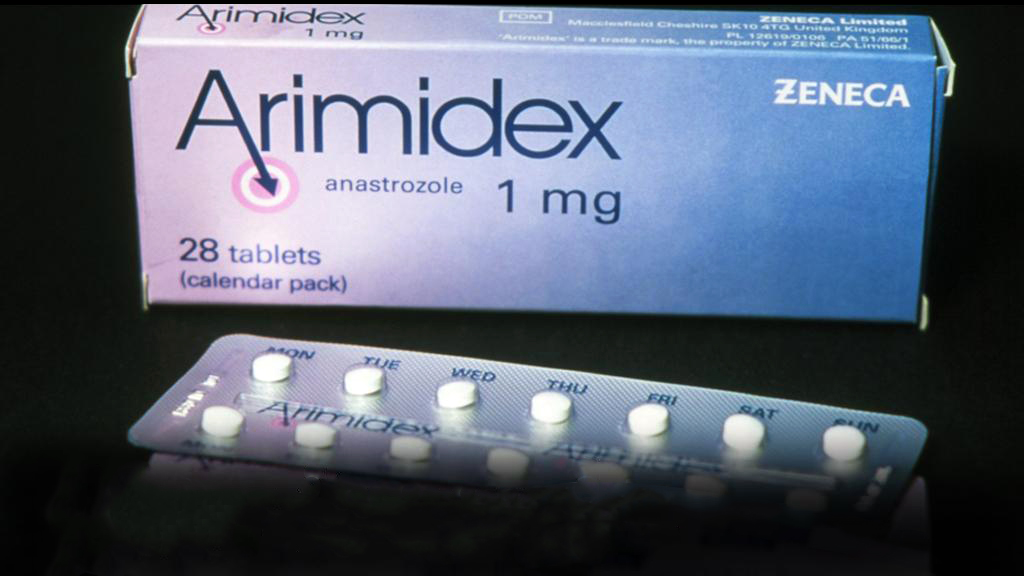Description
Buy ARIMIDEX Anastrozole tablets 1 mg #28 Take orally.
Description of Arimidex 1 mg
Arimidex is a powerful and highly selective non-steroidal aromatase inhibitor. In postmenopausal women, estradiol is mainly produced by converting androstenedione to estrone in peripheral tissues with the participation of the aromatase enzyme, then estrone is converted to estradiol. Lowering the level of estradiol in the blood has a therapeutic effect in women with breast cancer.
ARIMIDEX (Anastrozole) is used with other treatments, such as surgery or radiation, to treat early breast cancer in women who have experienced menopause (change of life; end of monthly menstrual periods). This medication is also used in women, who have experienced menopause, as a first treatment of breast cancer that has spread within the breast or to other areas of the body. This medication is also used to treat breast cancer in women whose breast cancer has worsened after taking tamoxifen (Nolvadex). ARIMIDEX (Anastrozole) is in a class of medications called nonsteroidal aromatase inhibitors. It works by decreasing the amount of estrogen the body makes. This can slow or stop the growth of many types of breast cancer cells that need estrogen to grow.
Ingredients:
Active ingredient: ANASTROZOLE, 1mg
Inactive ingredients: lactose, magnesium stearate, hydroxypropylmethylcellulose, polyethylene glycol, povidone, sodium starch glycolate, and titanium dioxide.
Indications for use of Arimidex 1 mg:
Adjuvant Treatment. ARIMIDEX is indicated for adjuvant treatment of postmenopausal women with hormone receptor-positive early breast cancer.
First-line Treanment. ARIMIDEX is indicated for the first-line treatment of postmenopausal women with hormone receptor-positive or hormone receptor unknown locally advanced or metastatic breast cancer.
Second-line Treatment. ARIMIDEX is indicated for the treatment of advanced breast cancer in postmenopausal women with disease progression following tamoxifen therapy. Patients with ER-negative disease and patients who did not respond to previous tamoxifen therapy rarely responded to ARIMIDEX.
Pharmacologial Properties of Arimidex 1 mg:
Effect on Estradiol. Mean serum concentrations of estradiol were evaluated in multiple daily dosing trials with 0.5, 1, 3, 5, and 10 mg of ARIMIDEX in postmenopausal women with advanced breast cancer. Clinically significant suppression of serum estradiol was seen with all doses. Doses of 1 mg and higher resulted in suppression of mean serum concentrations of estradiol to the lower limit of detection (3.7 pmol/L). The recommended daily dose, ARIMIDEX 1 mg, reduced estradiol by approximately 70% within 24 hours and by approximately 80% after 14 days of daily dosing. Suppression of serum estradiol was maintained for up to 6 days after cessation of daily dosing with ARIMIDEX 1 mg.
The effect of ARIMIDEX in premenopausal women with early or advanced breast cancer has not been studied. Because aromatization of adrenal androgens is not a significant source of estradiol in premenopausal women, ARIMIDEX would not be expected to lower estradiol levels in premenopausal women.
Effect on Corticosteroids:
In multiple daily dosing trials with 3, 5, and 10 mg, the selectivity of anastrozole was assessed by examining effects on corticosteroid synthesis. For all doses, anastrozole did not affect cortisol or aldosterone secretion at baseline or in response to ACTH. No glucocorticoid or mineralocorticoid replacement therapy is necessary with anastrozole.
Other Endocrine Effects. In multiple daily dosing trials with 5 and 10 mg, thyroid stimulating hormone (TSH) was measured; there was no increase in TSH during the administration of ARIMIDEX. ARIMIDEX does not possess direct progestogenic, androgenic, or estrogenic activity in animals, but does perturb the circulating levels of progesterone, androgens, and estrogens.
Pharmacokinetics of Arimidex 1 mg:
Adsortion. Inhibition of aromatase activity is primarily due to anastrozole, the parent drug. Absorption of anastrozole is rapid and maximum plasma concentrations typically occur within 2 hours of dosing under fasted conditions. Studies with radiolabeled drug have demonstrated that orally administered anastrozole is well absorbed into the systemic circulation. Food reduces the rate but not the overall extent of anastrozole absorption. The mean C max of anastrozole decreased by 16% and the median Tmax was delayed from 2 to 5 hours when anastrozole was administered 30 minutes after food. The pharmacokinetics of anastrozole are linear over the dose range of 1 to 20 mg, and do not change with repeated dosing. The pharmacokinetics of anastrozole were similar in patients and healthy volunteers.
Distribution. Steady-state plasma levels are approximately 3-to 4-fold higher than levels observed after a single dose of ARIMIDEX. Plasma concentrations approach steady-state levels at about 7 days of once daily dosing. Anastrozole is 40% bound to plasma proteins in the therapeutic range.
Metabolism. Metabolism of Anastrozole occurs by N-dealkylation, hydroxylation and glucuronidation. Three metabolites of anastrozole (triazole, a glucuronide conjugate of hydroxy-anastrozole, and a glucuronide conjugate of Anastrozole itself) have been identified in human plasma and urine. The major circulating metabolite of anastrozole, triazole, lacks pharmacologic activity.
Anastrozole inhibited reactions catalyzed by cytochrome P450 1A2, 2C8/9, and 3A4 in vitro with Ki values which were approximately 30 times higher than the mean steady-state Cmax values observed following a 1 mg daily dose. Anastrozole had no inhibitory effect on reactions catalyzed by cytochrome P450 2A6 or 2D6 in vitro. Administration of a single 30 mg/kg or multiple 10 mg/kg doses of anastrozole to healthy subjects had no effect on the clearance of antipyrine or urinary recovery of antipyrine metabolites.
Excretion. Eighty-five percent of radiolabeled anastrozole was recovered in feces and urine. Hepatic metabolism accounts for approximately 85% of anastrozole elimination. Renal elimination accounts for approximately 10% of total clearance. The mean elimination half-life of anastrozole is 50 hours.
Effect of Gender and Age. Anastrozole pharmacokinetics have been investigated in postmenopausal female volunteers and patients with breast cancer. No age-related effects were seen over the range 50 to 80 years.
Effect of Race. Estradiol and estrone sulfate serum levels were similar between Japanese and Caucasian postmenopausal women who received 1 mg of anastrozole daily for 16 days. Anastrozole mean steady-state minimum plasma concentrations in Caucasian and Japanese postmenopausal women were 25.7 and 30.4 ng/mL, respectively.
Effect of Renal Imprairment. Anastrozole pharmacokinetics have been investigated in subjects with renal impairment. Anastrozole renal clearance decreased proportionally with creatinine clearance and was approximately 50% lower in volunteers with severe renal impairment (creatinine clearance < 30 mL/min/1.73m²) compared to controls. Total clearance was only reduced 10%. No dosage adjustment is needed for renal impairment.
Effect of Hepatic Imprairment. Anastrozole pharmacokinetics have been investigated in subjects with hepatic cirrhosis related to alcohol abuse. The apparent oral clearance (CL/F) of anastrozole was approximately 30% lower in subjects with stable hepatic cirrhosis than in control subjects with normal liver function. However, these plasma concentrations were still with the range of values observed in normal subjects. The effect of severe hepatic impairment was not studied. No dose adjustment is necessary for stable hepatic cirrhosis.
Contraindications for use Arimidex 1 mg:
- ARIMIDEX is contraindicated in any patient who has shown a hypersensitivity reaction to the drug;
- ARIMIDEX may cause fetal harm when administered to a pregnant woman and offers no clinical benefit to premenopausal women with breast cancer;
- ARIMIDEX is contraindicated in women who are or may become pregnant. There are no adequate and well-controlled studies in pregnant women using ARIMIDEX.
Side effects:
Hot flashes, headache, trouble sleeping, dizziness, stomach upset, nausea/vomiting, constipation, diarrhea, loss of appetite, weight gain, tiredness/weakness, increased coughing, or sore throat may occur. If any of these effects last or get worse, tell your doctor or pharmacist promptly.
Remember that your doctor has prescribed this medication because he or she has judged that the benefit to you is greater than the risk of side effects. Many people using this medication do not have serious side effects.
Interaction with other medicinal products:
Anastrozole in vitro inhibits CYP 1A2, 2C8/9 and 3A4 enzymes. Clinical studies using antipyrine and warfarin have demonstrated that anastrozole 1 mg does not significantly inhibit the metabolism of antipyrine and R- and S-warfarin, and these data indicate that the simultaneous use of Arimidex with other drugs is unlikely to lead to clinically significant drug interactions. . mediated by CYP enzymes.
Enzymes mediating the metabolism of anastrozole have not been identified. Cimetidine, a weak non-specific inhibitor of CYP enzymes, does not affect the plasma concentrations of anastrozole. No data are available on the effects of potent CYP inhibitors.
Examination of the database on the safety of the drug, accumulated in the course of clinical trials, did not reveal information about clinically significant drug interactions in patients who took Arimidex concomitantly and other commonly prescribed drugs. No clinically significant interactions with bisphosphonates have been reported.
The simultaneous use of tamoxifen or estrogenic agents with Arimidex should be avoided, as this may weaken its pharmacological action.
Overdose of Arimidex 1 mg:
A single dose that results in life-threatening symptoms has not been established. There is no specific antidote to overdosage and treatment must be symptomatic. In the management of an overdose, consider that multiple agents may have been taken. Vomiting may be induced if the patient is alert. Dialysis may be helpful because ARIMIDEX is not highly protein bound.
Storage:
Store at room temperature between 20°C to 25°C / 68°F to 77°F.
Keep out of the reach of children.
Shelf life:
5 years.





Reviews
There are no reviews yet.